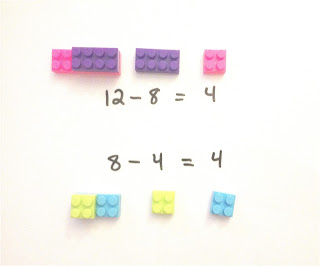
Addition – Write out simple addition equations on a
piece of paper. Leave enough space for your child to match the number
of pegs on each block with the written number. Or you could reverse it,
place the pegs on the table and ask your child to write out the numbers
that match the pegs.
Subtraction – Place one Lego that has fewer pegs on top
of another that has more to reveal subtraction concepts. For example, a
12-peg Lego beneath an 8-peg Lego of the same color that is being
subtracted, helps children to put quantities into groups.
Recognizing Patterns – Choose two or three different
colors, and have your child create various pattern types. Or create the
pattern yourself and have your child to determine what the pattern is.
Comparing Numbers – Stack up blocks next to each other,
and ask your child which one contains more. Then demonstrate how the
greater than/less than symbol indicates the amount as well.
Measuring – Take any toy that your child likes and use Legos to measure them. Then ask how many Legos long is your toy?
Multiplication and Division – Use larger Legos or Duplos to show groups.
Three groups of eight make twenty four. Then write out the equation, 3
x 8 = 24. You could also write out 8 + 8 + 8 = 24, to show that
multiplication is repeated addition.
Counting and Number Matching – This next one works
better on bigger blocks, like Lego Duplos. I used a small dry erase
marker to write on the blocks. They erase well with the wipe of a
tissue. Separate the blocks, write the numbers on them, then have your
child to match them up. This will help them learn to relate the
cardinal number to the written number, and to the quantity – represented
in the dots.
Putting the Alphabet in Order – Mix up blocks and
spread them out, then have your child to put them in order. Make this
activity more fun by having your child sing the alphabet song while
playing the game, or race against a timer.
Sentence Structure – Write a simple sentence, like the
one below. Mix up all the words, and have your child to place them in
order, to form a complete sentence.
Prefixes – Write the prefix on the smaller block, and the root word on the larger block to demonstrate how the prefix changes the word.
Suffixes – Write the suffix on the smaller block, and the root word on the larger block to demonstrate how the suffix changes the word.
Subject & Predicate – Write a basic sentence and
then choose two large blocks on which to write ‘subject’ and
‘predicate.’ You can do this with nouns and verbs, or if your child is
more advanced, use subjects and predicates. But use the larger blocks
to label the parts of the sentence, and smaller blocks to write the
words.
















I'm so mad at myself right now, I threw away a lot of those F'egos (fake Legos) from Target because they weren't great for playing. With these ideas, I'm going to run down there today and purchase them...again. The language arts component is genius. Thanks for sharing!
ReplyDeleteGreat variety of number sense, writing, and recognition activities included in this blog post! Thanks! We have an educational website and popular kids songs to help kids and their parents to find out activities that helps in their overall growth.
ReplyDelete